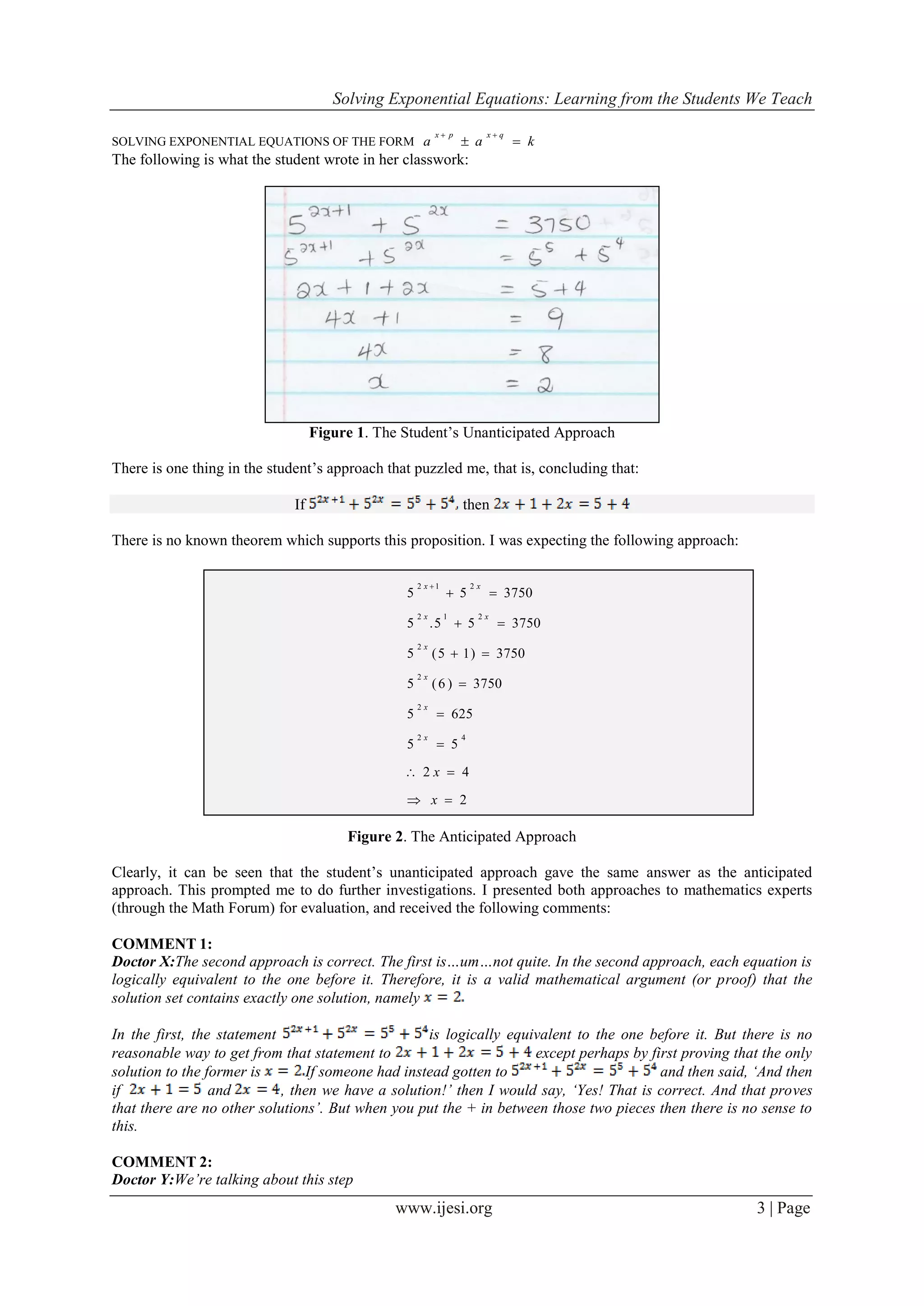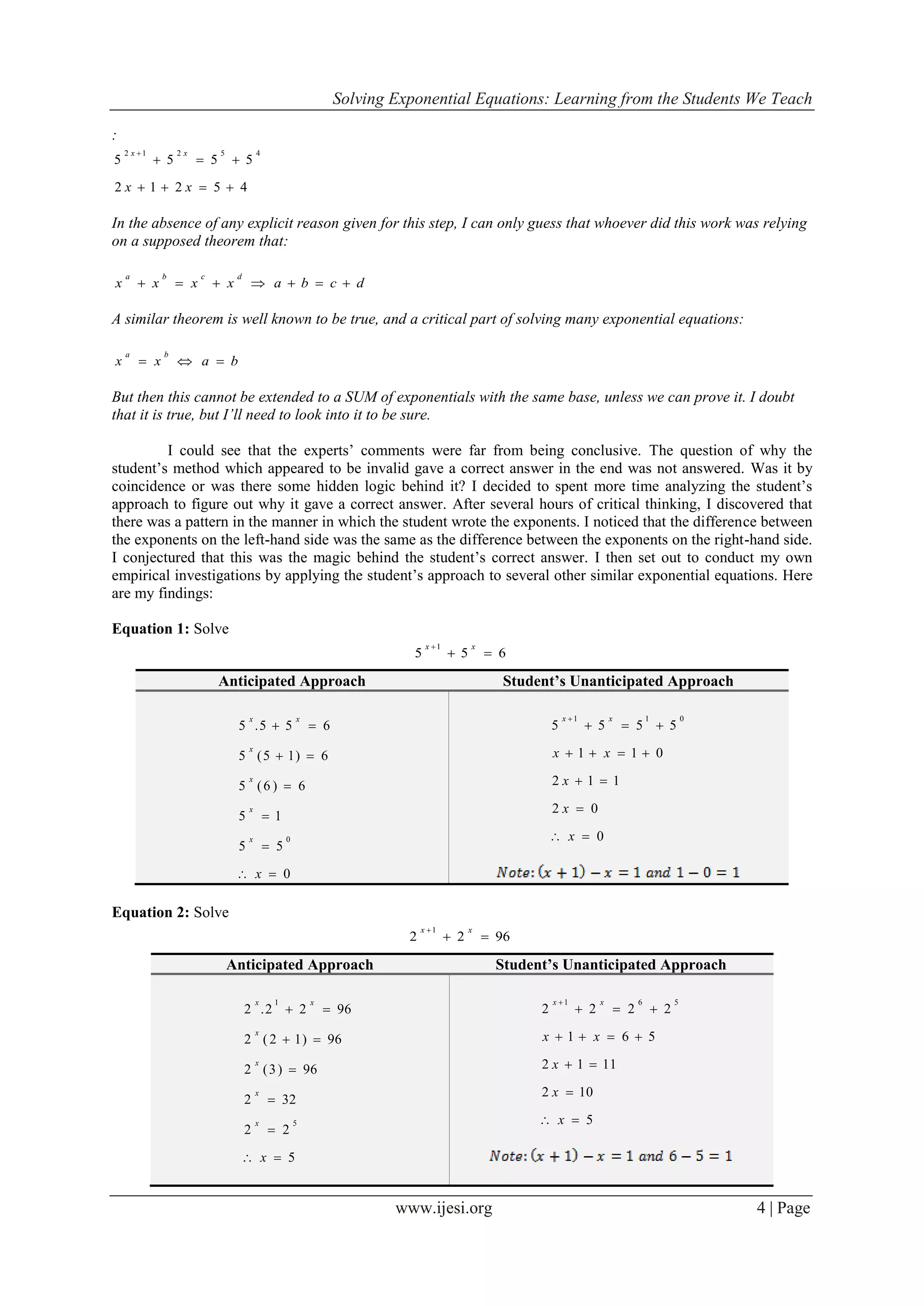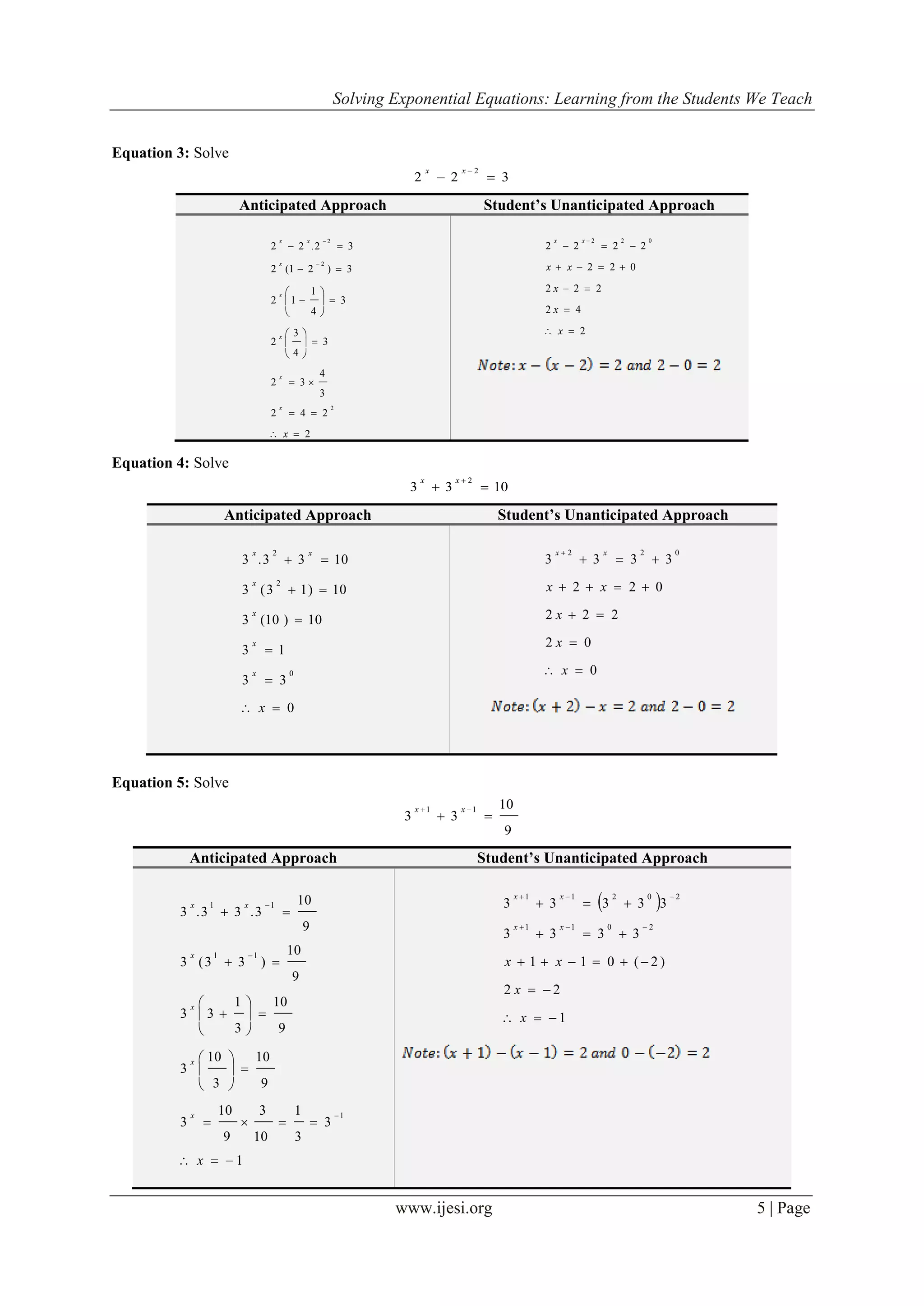This paper examines a grade 11 student's unconventional method for solving exponential equations that produced correct answers despite not conforming to established mathematical laws. The author, after analysis and empirical investigation, concludes that the student's approach contains valid reasoning which may not be recognized by traditional teaching. It urges mathematics educators to be open to unique student methods, as they may reveal new insights and valid solutions that challenge existing frameworks.
![International Journal of Engineering Science Invention
ISSN (Online): 2319 – 6734, ISSN (Print): 2319 – 6726
www.ijesi.org ||Volume 6 Issue 5|| May 2017 || PP. 01-07
www.ijesi.org 1 | Page
Solving Exponential Equations: Learning from the Students We Teach
Eric Machisi
Institute for Science & Technology EducationUniversity of South Africa
Abstract: The purpose of this paper is to share with the mathematics community what I discovered from
analyzingone of myGrade 11 students’ approach to solving exponential equations of the form
kaa
qxpx
, where a and k are positive integers greater than 1, and qp , . The student got a
correct answer using a procedure which does not conform with the known exponential laws, thereby making it
difficult to evaluate the student’s work. I gave the student’s script to fellow mathematics educators and they
marked the student wrong, arguing that laws of exponents cannot be extended to a sum or difference of
exponentials with the same base. Ithen decided to present the student’s solution method to other mathematics
experts (through the Math Forum)for further evaluation. The responses and comments I received were far from
being conclusive. It was suggested that there was need to use mathematical proof to verify whether the student’s
approach was valid or not. I then set out to investigate why what looked like invalid reasoning on the surface
gave the right answer in the end.After a careful analysis of the student’s approach, coupled with some kind of
empirical investigations and mathematical proof, I eventually discovered that there was some logic in the
student’s approach, only that it was not supported by the known theory of exponents. I therefore recommend
that mathematics educators should not take students’ solution methods for granted. We might be marking some
of the students’ solution methods wrong when they are valid, and robbing them of their precious marks. It is
possible for students to come up with new and valid methods of solving mathematics problems which are not
known to the educators.Good mathematics educators should therefore be on the lookout for new unanticipated
approaches to solving mathematical problems that students of exceptional abilities may use in class. The famous
German mathematician and astronomer, Carl Friedrich Gauss (1777-1855)amazed his teachers when he
discovered a quick way of summing the integers from 1 to 100, at the age of seven. Such exceptional intellectual
abilities still existeven in school children of today.
Key Terms: Exponents, exponential equations, anticipated approach, unanticipated approach
I. Introduction
Exponents, which indicate how many times a number multiplies itself, are fundamental in the modern
technological world.Exponents are used by Computer Programmers, Bankers, Investors, Accountants,
Economists, Insurance Risk Assessors, Chemists, Geologists, Biologists, Physicists, artisans, Sound Engineers
and Mathematicians, to solve real life problems [1]. For instance, investors simply plug in numbers into
exponential equations and they are able to figure out how much they are earning on their savings. Banks use
exponential equations to calculate how much borrowers have to repay each month to settle their loans.
Geoscientists use exponents to calculate the intensity of an earthquake. Builders and carpenters use exponents
daily to calculate the quantity of material needed to construct buildings. Aeronautical engineers apply
knowledge of exponents to predict how rockets and jets will perform during a flight.Clearly, exponents are a
necessary component of the school mathematics curriculum to prepare students for these critical careers.
In South Africa, Grade 10 and 11 students are expected to use laws of exponents to solve exponential
equations[2], including those of the form kaa
qxpx
. Examples of such equations are:
1033
2
xx
11333
312
xxx
322
2
xx
655
1
xx
In solving these equations, we rely mainly on the exponential theorem which states that:
If
cx
aa , then cx .
It is not known whether this could be extended toa sum or difference of exponentials with the same base.For
instance, we do not have theorems suggesting that:
srqxpxaaaa
srqxpx
](https://image.slidesharecdn.com/a06050107-170511041201/75/Solving-Exponential-Equations-Learning-from-the-Students-We-Teach-1-2048.jpg)
![Solving Exponential Equations: Learning from the Students We Teach
www.ijesi.org 2 | Page
However, one of my Grade 11 students used a technique that seemed to suggest the existence of such
theorems. The student got a correct answer using a procedure that seemed to be invalid because it did not
conform with the known theorems of exponents. I therefore set out to investigate the reason why an approach
that seemed invalid on the surface, gave a correct answer in the end. In this paper, I intend to share with the
mathematics community what I discovered from analysing the student method of solution.
II. Theoretical Framework
Mathematics is “a human activity that involves observing, representing and investigating patterns and
qualitative relationships in the physical and social phenomena and between mathematical objects themselves”
[2, p. 8]. Mathematical problem solvingteaches us to think critically, logically and creatively [2].Contemporary
views of mathematics education encourage students to use their own methods to solve problems rather than
imitate their teachers. This is in line with the constructivist view of mathematics teaching and learning which
states that students have the ability to construct their own knowledge through discovery and problem solving.
Constructivism “gives preeminent value to the development of students’ personal mathematical ideas” [3,p.
9].In a traditional mathematics classroom, it is predetermined that students will solve mathematics problems
using the method(s) shown to them by their teacher. This is in sharp contrast to a constructivist mathematics
classroom where students employ different and multiple solution methods. “Students may use unanticipated
solution-methods and unforeseen difficulties may arise”[4, p. 3].The role of the teacher in this context becomes
more demanding and unless the teacherlooks more closely at what the students have written, some solutionsrisk
being marked wrong when they are valid.A good mathematics teacher understands that there are multiple ways
of solving mathematics problems, and hence seriously considersevery attempt that students make towards
solving a mathematics problem.
III. Purpose of The Study
The purpose of this study was to explore the logic behind one of my Grade 11 students’ unanticipated
approach to solving exponential equations of the form kaa
qxpx
,which resulted in a correct answer,
using what seemed to be an invalid procedure. Findings of this study were intended to assist the researcher in
deciding whether or not the student’s method could be accepted as valid.
IV. Methodology
This investigation utilized the single-case study design with only one Grade 11 student as the unit of
analysis. According to Yin [5], a single-case study is appropriate under the following circumstances: (a) where
it represents a critical case that can be used to confirm, challenge or extend a well-formulated theory, (b) where
it represents a unique case, and (c) where it makes a significant contribution to knowledge or theory building.
All the three circumstances were found to match the present investigation perfectly.Data were collected from the
student’s classwork book. The focus of the study was on the student’s approach to solving exponential equations
of the form kaa
qxpx
. The student’s solution method which was a unique case, was presented to the
Math Forum for evaluation. Two mathematics experts, Doctor X and Doctor Y (not their real names), responded
through email. After analyzing their comments, I decided to conduct my own empirical investigations by
applying the student’s unanticipated approach to several other similar exponential equations and compared the
results with those obtained using the anticipated (usual) approach.The findings of the study are presented in the
next section.
V. Findings](https://image.slidesharecdn.com/a06050107-170511041201/75/Solving-Exponential-Equations-Learning-from-the-Students-We-Teach-2-2048.jpg)



![Solving Exponential Equations: Learning from the Students We Teach
www.ijesi.org 6 | Page
VI. Discussionof Results
After trying out several cases, I concluded that it was not by coincidence that the student’s
unanticipated approach to solving exponential equations gave a correct answer. Indeed, the student’s technique
works under certain conditions. The only problem with the student’s presentation was that it was not backed up
by the known exponential laws and lacked the necessary details to assist the educator in marking thestudent’s
work. The student therefore risked being marked wrong because the logic behind the student’s approach was not
easily discernible. There is no known theorem which suggests that:
If , then .
Based on my findings from using the student’s technique in several similar cases, I would like to propose the
possibility of developing such a theorem, under certain restrictions:
Proof:
Suppose where ,
Then we have: (*)
(1)
If then from equation (*), , which implies that: (2)
If results (1) and (2) are true, then it is also holds true that (3)
Result (3) explains why the student’s unanticipated approach gave a correct answer in the end. I therefore argue
here that my student’s solution method is acceptable and I am inviting the mathematics community to criticize
these findings.
VII. Recommendations
Based on the findings of this investigation, I strongly urge fellow mathematics educators to closely
examine students’ solutions to avoid marking them wrong when they are right. Some of the methods of
solutions that students may use might be completely new and unfamiliar to the educator. Like the famous
German mathematician Carl Friedrich Gauss (1777-1855) who discovered a quick way of adding natural
numbers from 1 to 100 at the age of seven, these young minds should not be looked down upon. Some of the
students we teach possess exceptional intellectual abilities that need to be nurtured and not suppressed. Good
mathematics teachers should therefore be ready to learn even from their own students. Finally, I recommend
further studies on the possibility of extending exponential laws to a sum or difference of exponentials.
References
[1] Passy, “Exponents in the Real World,” 17 May 2013. [Online]. Available:
http://passyworldofmathematics.com/exponents-in-the-real-world/. [Accessed 1 April 2017].
[2] Department of Basic Education, Curriculum and Assessment Policy Statement, Further Education and
Training Phase, Grades 10-12 Mathematics, Pretoria: Department of Basic Education, 2011.
[3] B. Monoranjan, “Constructivism approach in mathematics teaching and assessment of mathematical
understanding,” Basic Research Journal of Education Research and Review, vol. 4, no. 1, pp. 8-12, January](https://image.slidesharecdn.com/a06050107-170511041201/75/Solving-Exponential-Equations-Learning-from-the-Students-We-Teach-6-2048.jpg)
![Solving Exponential Equations: Learning from the Students We Teach
www.ijesi.org 7 | Page
2015.
[4] S. Evans and M. Swan, “Developing Students Strategies for Problem Solving in Mathematics: the role of
pre-designed "Sample Student Work",” Journal of International Society for Design and Development in
Education, vol. 2, no. 7, pp. 1-31, 2014.
[5] R. K. Yin, Case Study Research: Design and Methods, 5th ed., Los Angeles: SAGE Publications, 2013.](https://image.slidesharecdn.com/a06050107-170511041201/75/Solving-Exponential-Equations-Learning-from-the-Students-We-Teach-7-2048.jpg)